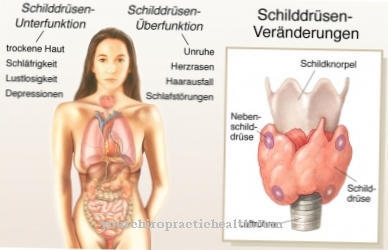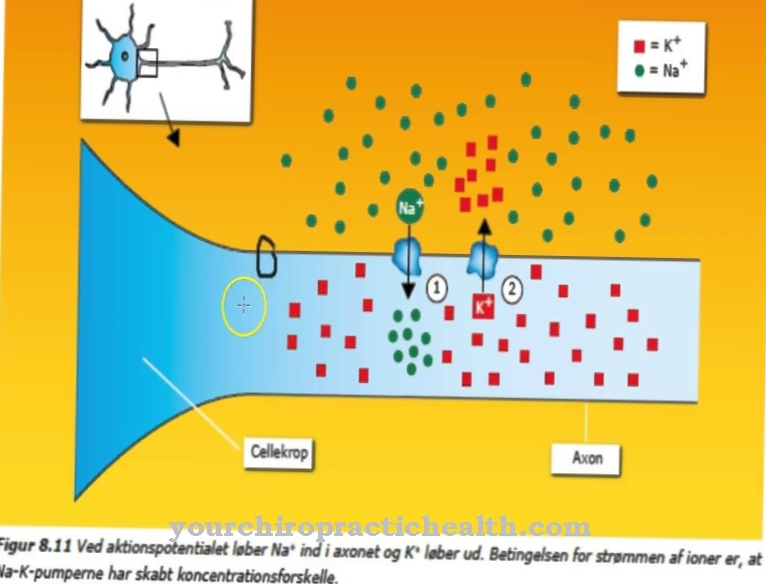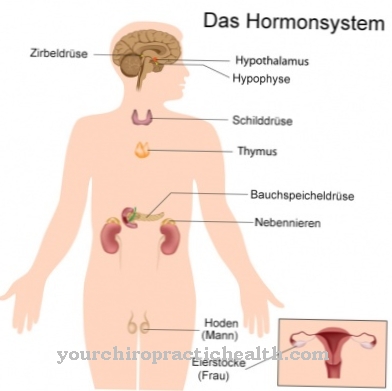Ceruloplasmin is a protein found in blood plasma. It is a ferro oxidase, an enzyme that plays an important role in the storage of copper. The determination of ceruloplasmin gives information about the iron and copper metabolism.
What is ceruloplasmin?
Caeruloplasmin is also known as ceruloplasmin. It is the protein that is mainly responsible for transporting copper in the blood. In addition, ceruloplasmin is an essential part of iron metabolism.
It belongs to the group of copper-dependent ferroxidases. Caeruloplasmin has homologies, similarities with the protein Hephaestin. This protein is also important for iron metabolism. Hephaestein is a transmembrane copper-binding ferroxidase. It transports iron from the enterocytes of the intestine, which take up iron from food, to the bloodstream.
Function, effect & tasks for body and health
Caeruloplasmin binds over 95% of the copper in human serum. It is also an essential part of iron metabolism. It oxidizes iron, which is bound to ferritin. Fe3 + is formed from Fe2 +. Oxidation is a chemical reaction in which an atom loses electrons and thereby increases its positive charge.
If another atom accepts these released electrons, then one speaks of a redox reaction, since one atom is reduced and another atom is oxidized. The ceruloplasmin is used to transport copper with the help of the transferrin. Transferrin is a glycoprotein that can only bind and transport Fe3 +. Iron is an important part of the protein hemoglobin and myoglobin. Hemoglobin is an iron-containing protein found in red blood cells and gives them their red color. It is used to transport oxygen in the blood. Myoglobin is a protein found in muscles. It is also a red protein which, together with other enzymes, the hydrogenases and the oxidases, binds oxygen in the muscle. In addition, iron is involved in electron transport in mitochondria, the power plants of the cell.
Education, occurrence, properties & optimal values
Ceruloplasmin has a molecular mass of 151 kDa. It is mainly made in the liver and brain. The synthesis of ceruloplasmin is not influenced by a change in the amount of copper. After synthesis, each protein is loaded with six to eight copper ions. Men and women had an average ceruloplasmin concentration of 20 to 60 mg / dl. The amount of copper in the human body is around 70 to 150 mg. The iron concentration in men is between 60 and 160 µg / dl and in women between 40 and 150 µg / dl.
Diseases & Disorders
The concentration of ceruloplasmin in the blood can be changed by various diseases or life circumstances. Long-term malnutrition is one of these circumstances.
There is a chronic copper deficiency, which, in contrast to a short-term copper deficiency, can influence the concentration of ceruloplasmin. Another reason can be a reduced expression of the gene which codes for ceruloplasmin. Menkes syndrome is a condition associated with decreased levels of ceruloplasmin. This disease is a congenital metabolic disorder. Movement disorders occur due to muscle weakness. The connective tissue loses its elasticity.
This is also known as seborrheic dermatitis. The hair loses its structure and becomes brittle. A funnel breast may partially form. There is also an increased incidence of inguinal hernias. The cause of this disease lies in the disturbed transport of copper through the intestine. Another disease in which there is a decreased amount of ceruloplasmin is Wilson's syndrome. Like Menkes syndrome, it is a genetic disease. This disease causes excessive accumulation of copper, which has serious consequences for the liver and the brain. As a result, the functions of the brain and liver are restricted.
It can lead to acute liver failure. Neurological symptoms can also occur in patients. After the onset of Wilson syndrome, symptoms similar to those of Parkinson's patients can occur. These include slow movements, loss of balance, hand tremors, or ataxia. Ataxia is generally a movement disorder. Different forms of ataxia are distinguished; the run ataxia, the gait ataxia and the standing ataxia. In addition, a lack of ceruloplasmin can result from a vitamin C overdose or from acaeruloplasminemia.
In acaeruloplasminemia, a mutation leads to a malfunction of the ability of ceruloplasmin to function as ferroxidase. It is no longer able to oxidize iron. Iron builds up in the human body. The accumulation of Fe2 + in high doses is toxic to humans. This accumulation occurs mainly in the liver, pancreas and brain. The result is diseases such as diabetes mellitus, retinal degeneration and neurological impairments such as dementia or ataxia.
An increase in the amount of ceruloplasmin can be triggered by pregnancy, the use of birth control pills, Alzheimer's disease or schizophrenia. Further reasons for increased ceruloplasmin values are rheumatoid arthritis and angina. Arthritis is inflammation of the joints. Angina describes a variety of diseases. This includes the best known angina pectoris, which mainly leads to pain in the chest area.












.jpg)



.jpg)










.jpg)
